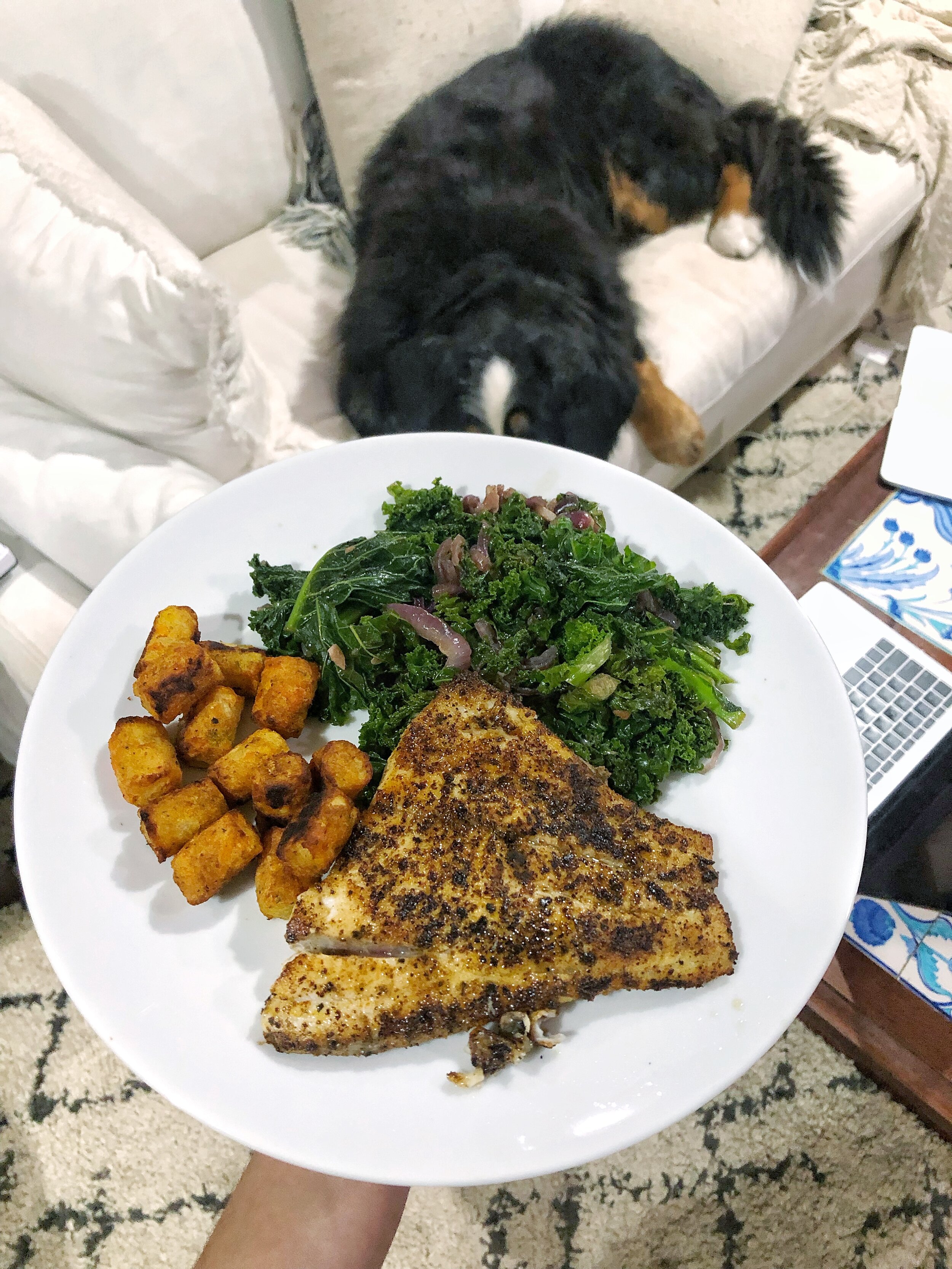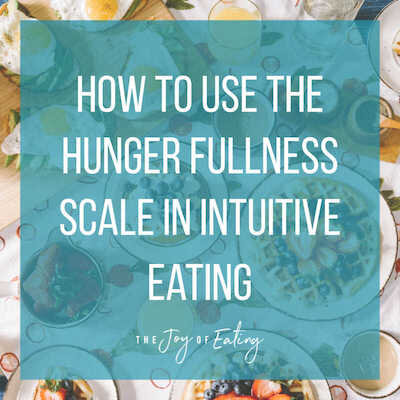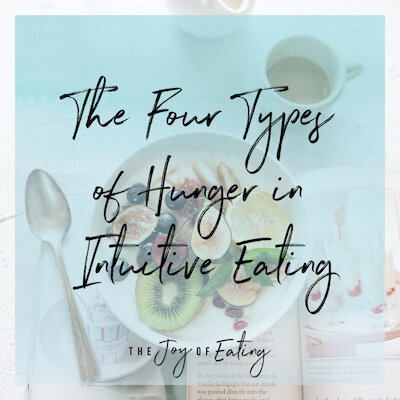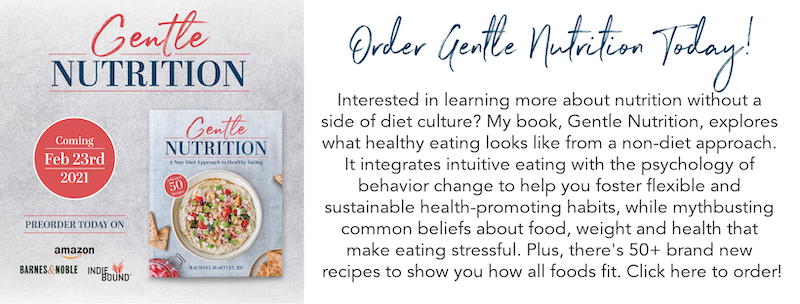Why am I Feeling Hungry After Eating? Satisfaction vs. Fullness in Intuitive Eating
Wondering why am I feeling hungry after eating? Intuitive eating is all about using internal cues, like hunger and fullness, to guide eating. But sometimes Intuitive Eating is taught as a "hunger/fullness" diet, which overlooks the importance of satisfaction, which is an even more important cue to stop eating. Learn the difference between satisfaction and fullness in intuitive eating.
When I work with new clients on intuitive eating, feeling confused by hunger and fullness cues is not an unusual thing to experience, especially for anyone who has been a chronic dieter. Diets often tell you exactly how much to eat, so regardless of whether you feel like you’ve had enough, you make do (until you inevitably don’t).
Intuitive eating, on the other hand, recognizes that one of the main purposes of eating is fueling your body adequately. Unlike dieting, which approaches food as the least amount you can eat without keeling over or murdering someone in a hanger induced rage, intuitive eating aims to provide an amount and balance of food that leaves you feeling energized and fueled for a reasonable amount of time. That way you can focus on non-food related activities.
But what happens when you’re feeling hungry after eating and you’ve eaten what you feel like “should” be enough? This post will focus on satisfaction vs. fullness in intuitive eating, and how lack of satisfaction can contribute to this. But first, a couple other factors to consider.
Why am I Feeling Hungry After Eating?
Are you truly eating enough?
Often times your idea of what should be enough is based on diet cultures version of what’s considered enough. Which is clearly inadequate. Many times when I see or hear the amount of food clients think they should be eating, it’s not nearly enough. Human bodies need a lot more food than most people think.
The hunger/fullness scale is a helpful tool that can help you figure out how much to eat, and what it feels like when you’re no longer hungry vs filling up vs. satisfied. This post better explains how to use the hunger/fullness scale in intuitive eating. If you feel really disconnected from how much to eat, it can be helpful to work with an intuitive eating dietitian.
Sometimes capping off a meal with dessert is what makes it satisfying!
Did you eat a filling meal?
It’s also worthwhile to make sure you’ve actually planned a filling meal with fat, protein, carbohydrate and most of the time, some produce too. Because while you could physically fill up on produce or protein, your body won’t be satiated unless you’ve provided it with all three macronutrients. While the stretch of your stomach as it fills up with food signals one satiety cue, glucose, fatty acids and protein all send separate signals to the brain to turn down the hunger cues and increase the fullness cues. That’s why filling meals contain a balance of macronutrients.
You can make super satisfying meals at home in less than 30 minutes! Sautéed a baramundi filet spiced with cajun seasoning and served it with Dr. Praeger’s carrot puffs, and kale sauteed with red onion.
Satisfaction vs. Fullness in Intuitive Eating
Now, let’s get to the meat of this convo - the difference between satisfaction and fullness in intuitive eating.
Let me preface this by saying that I have this little beef with how intuitive eating is often translated - as a "hunger/fullness diet.” While intuitive eating is all about using internal cues, including hunger/fullness, as well as how food makes you feel, taste preferences, etc., it’s so much more nuanced than that. When you inevitably eat past the point of fullness because a.) life, it happens or b.) sometimes it’s enjoyable to eat a bit past fullness, you might end up feeling like you “failed” intuitive eating, throwing you right back into the diet cycle of shame, restriction, etc. Also, the very simple (and mostly helpful) advice of eat when you’re hungry, stop when you’re full, doesn’t capture the fact that as human beings, we eat for reasons other than hunger - and that’s OK!
With the hunger/fullness scale, it’s also easy to forget to consider satisfaction. To explain the difference between fullness and satisfaction to my clients, I say that fullness is a physical sensation of satiety, while satisfaction is the mental sensation of satiety.
If you’re wondering why am I feeling hungry after eating, it is possible that you’re full but not satisfied. I could eat a big mostly vegetable salad to the point where my stomach was stretched out and I felt physically full … but I wouldn’t feel satisfied. I could also eat a meal that had enough energy, fat, protein and carbohydrates to meet my physical needs, but if the food that provided it wasn’t enjoyable, I probably wouldn’t feel satisfied.
Satisfaction turns off the drive to eat more so than fullness. If you’re not feeling satisfied after a meal, you’re likely to continue seeking out food in an attempt to get that satisfaction. And if you’re feeling guilty about seeking out food, rather than just giving yourself permission to eat a little more, it’s likely to trigger binging/overeating/grazing/etc.
Also, you just deserve to feel satisfied by what you’re eating.
I see this happen a lot with my clients who are sticking to mainly “healthy” foods. If you’re choosing foods you think you should eat and not the foods you want to eat, it’s unlikely you’ll have a very satisfying eating experience.
My favorite salad in Columbia! This bad boy is topped with smoked barbecue chicken, smoked corn, blue cheese, pickled okra and cherry tomatoes, and cucumbers. I was hungry, but also in the mood for something fresh and crisp tasting, and this hit the spot!
What makes a satisfying meal?
Generally speaking, satisfying meals contain fat, protein and carbohydrate. While high volume/low calorie foods can signal fullness by filling up your stomach, fat, protein and carbohydrate all signal fullness in other ways (i.e. by bringing blood sugar back to normal, by releasing hunger suppressing hormones, like cholecystokinin, etc). Most of the time, to feel satisfied you’ll want to include all the macronutrients. Of course, this is a general rule of thumb, and sometimes what feels most satisfying might be a bowl of veggie soup or pasta with tomato sauce or meat and veggies.
Pleasure is also important for a satisfying meal. I’m sure you’ve had that experience of eating a meal that typically would be enough to satisfy, but it either didn’t taste good, or wasn’t what you were in the mood for, so you still felt hungry. I was at an event recently where the food was pretty ick. I wanted to not be a miserable human being and have the energy to participate, so even though the food was kinda gross, I ate enough to feel full. But I wasn’t satisfied. So the first thing I did after the event was over was swing by Starbucks for a vanilla latte and their sous vide egg bites (which are fan-flippin-tastic), because I still was craving satisfaction.
Also, food can be satisfying without being filling (think candy, soda, or chips), so when deciding what to eat, you may want to consider both, and whether you are physically hungry or taste hungry. For example, you could be hungry and craving candy. But while candy might satisfy, it won’t fill you up. So perhaps you could have a meal or snack then eat some candy. That said, if you’re just taste hungry and not physically hungry, candy on it’s own would be enough satisfy.
Because sometimes you need three tacos and cheese grits to feel satisfied. Takeout meal from White Duck Taco (RIP).
Prioritizing satisfaction vs thinking about what fills your stomach up with the least calories may seem scary, but keep in mind that when you’re eating something satisfying, you’re more likely to stop at an appropriate point vs continuing to eat desperately trying to find a satisfaction that’s not coming. The perfect example of that is when you try to eat fruit instead of dessert, and end up eating 47 different things before just eating the thing you wanted in the first place.
Your environment can be part of what makes a meal satisfying too. That might mean putting on music, eliminating distractions (or adding distractions!), eating with people or eating solo.
Not all meals will be satisfying and that’s OK! Was running late to get to the office and grabbed this for lunch, even though I was hungry for something more filling and savory (those oats are real good though!). That’s life! I ended up having a more savory morning snack, and knew more satisfying meals were coming.
How to make a more satisfying meal?
One way I like to help my clients plan more satisfying meals is to think about adding the pleasure factor into their meals. The pleasure factor is different from person to person, based on their individual food preferences, but here’s some examples of what a pleasure factor might look like:
Roasting vegetables instead of steaming them
Adding a little butter for flavor
Using a seasoning mix you really enjoy
Having dessert after a meal
Using tasting sauces, like pesto, vinaigrettes or mustard
Using enough salt and black pepper
Choosing white rice, bread or pasta vs whole grain in dishes where you prefer the flavor
Adding cheese!
If you’ve been dieting for awhile, you might not know what foods you like. It’s so easy to lose touch with that after years of eating for calories/macronutrients vs satisfaction. If that’s the case, try to experiment with a wide range of food and notice what you enjoy.
Another way to make a more satisfying meal is to eat more mindfully. That doesn’t necessarily mean savoring every single bite or always eating with no distractions, because real life often involves eating in the car or with screaming kids or while working. And also, sometimes it’s most satisfying to eat in front of the TV or reading a book! But instilling some amount of mindfulness, perhaps by slowing down, reducing distractions or taking a few bites to notice your food can be helpful.
The environment you’re eating in can contribute to satisfaction. Enjoyed this cold noodle salad with mango and zucchini noodles at Riverfront Park one weekend.
Satisfaction is important!
As human beings, we evolved to seek pleasure from food! I think that’s a really lovely thing. Instead of trying to fight it, intentionally aim for satisfaction.
If you’re feeling hungry after eating - it may seem obvious but consider eating more - or something different! Just because you ate an amount you think should be enough, it might not be enough for that moment, or it just might not have the satisfaction factor you’re looking for.












